Famous Tea Houses
When the nightingales
Come to the capital
I’d like to lend them
My little hut–
plum blossoms are waiting.
–Rengetsu
Cha-shitsu is a small Japanese garden pavilion or room within a house, specifically designed for the tea ceremony. Ideally, the cha-shitsu, or tea house, is separated from the house and is through a small garden called a roji (“dewy path”), the first step in breaking communication with the outer world.
The tea house is usually a small, thatched-roof structure with plain plaster walls, whose several openings, placed at different heights and filled with shoji (sliding panels of wooden lattice covered with translucent paper), admit a soft, diffused light. A small, “kneeling-in” entrance, about 75 cm (2.5 feet) square, set above a stepping stone, is intended to inculcate humility in all who enter. The interior is large enough to accommodate five kneeling guests, which is the ideal number. The cha-shitsu is completely bare except for the tokonoma, the alcove in which paintings, pottery, flower arrangements, and other forms of art are displayed.
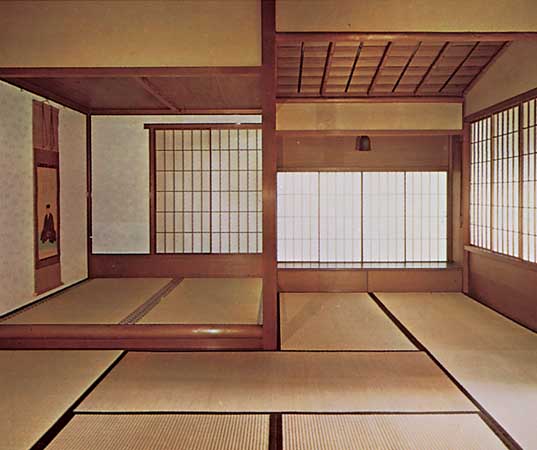 Interior of a cha-shitsu (tea house)
Interior of a cha-shitsu (tea house)
The most famous of all tea masters, Sen Rikyū (1522–91), was the first to build a cha-shitsu that was a separate structure instead of a special room within the house.
Kodaiji Temple Ihoan Tea Hut
The Ihoan tea hut (Cottage of Lingering Fragrance) was the favorite Tea ceremony room of Haiya Shoeki, a wealthy merchant, and Yoshino Dayu, a renowned beauty and dancer who later became Shoeki’s wife. Together with another tea ceremony house, the Onigawara-Seki, they are representative examples of Kodai-ji temple’s tea ceremony architecture.
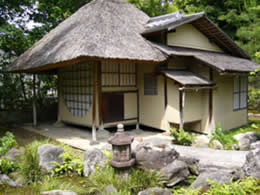 |
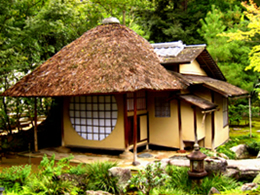 |
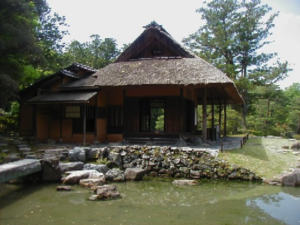 |
Katsura Rikyu Imperial Villa Shokin-tei
Crossing a large stone bridge brings the visitor to the entrance of the Shokin-tei, the most important tea pavilion at the villa.”Shokin” means the sound of a koto and the whistle of the wind passing through pine trees. Because the entrance is extremely small, visitors must hunch over to pass through to the interior. It is a typical Japanese pavilion and there are eight windows on the side of the entrance. A different perspective of the Shokin-tei can be enjoyed from the east, north, and west. The Ichi-no-ma, or first room, has a blue and white checkered pattern on the sliding door and tokonoma (alcove). This is the result of bold and flexible creativity and ingenuity and it appears as novel and contemporary today as it did back then.
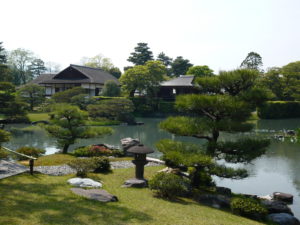 |
Katsura Rikyu Imperial Villa Geppa-ro
Geppa-ro is a tea pavilion standing on a promontory above the shore of the pond near the Koshoin. There is a spacious earthen area to the front-center of the Structure. Geppa-ro is a good place to watch the moon as the name of the pavilion indicates. Another feature is that there is no interior ceiling in the Geppa-ro tea pavilion and the back of the roof looks like the bottom of a boat.
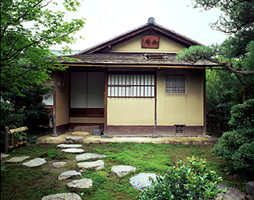 |
Jo-an Tea Pavilion
The interior of this tea room build by the younger brother of Oda Nobunaga, Oda Uraku (Jo-an), has a three-quarter size (daimedatami) tea master mat, a 2.5 mat (nijouhan tatami) for guests and a tokonoma. A base board creates a distinctive triangular section of floor next to the tokonoma, or alcove. The nakabashira, the pillar next to the mat with the ro, or hearth, skillfully demarcates the host and guest mats. Jo-an’s novel planar design is also notable for renjimado, windows covered by bamboo lathe work, and shitajimado, a kind of window made by not plastering over a section of wall and leaving the underlying lathe exposed, placed so as to provide the host’s mat with ample light as well as for the use of pages from old almanacs as wainscoting along the lower walls.
Jikou-in Tea Pavilion
Jikou-in was built by Katagiri Iwaminokami Sadamasa, the founder of the Sekishu school of tea, as a memorial to his father Katagiri Sadataka. The Shoin and tea room are the original buildings. The Shoin with its thatched roof and rustic exterior is surrounded by a beautifully tended garden. Pillars supporting the veranda are minimized so as to enhance the view of the garden from inside, so it is all the more regrettable that the surrounding area has gradually filled with homes. There are two tea pavilions.
# 855 Koizumi-cho Yamato-koriyama-shi, Nara prefecture.
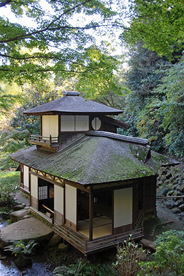 |
Choushukaku Residence in Sankei Garden
Originally located in Kyoto’s Nijo Castle, this tea room was build by the tea master Sakuma Sougen on the order of Tokugawa Iemitsu. It was later bequeathed to Lady Kasuga, and after several re-locations, eventually became a part of the garden of Taisho Era magnate and tea master Hara Sankei. The tea room’s two-story structure exhibits the lightness of form associated with the tea ceremony influenced “shoin-zukuri” style. Especially notable are the exquisitely crafted railing and other attention to detail as well as deliberately non-symmetrical “sukiya” style interior.
#58-1 Honmoku- sannotani Naka-ku Yokohama-shi, Kanagawa prefecture.
Isuitei Tea Pavilion
Located at Hashimoto Memorial Gardens Kyoto. These tea houses are build in a 2,200 square-meter landscape garden. Hashimoto who was a famous Japanese painter build his atelier here and made these tea houses for his wife. The buildings are surrounded by several ponds which are lined with rock formations. When in Kyoto one can visit one of the famous temples together with thousands of other visitors or consider this landscape garden with beautiful old buildings and a peaceful quiet surrounding. In August 2000 Hashimoto memorial garden has been designated a national scenic spot.
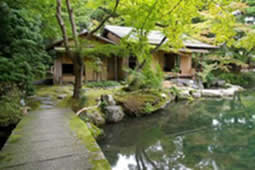 |
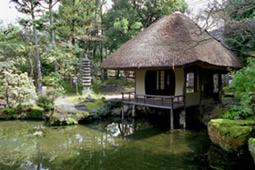 |
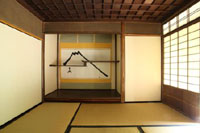 |
Kasumidoko-seki Tea Room
The Kasumidoko tea room is located at Gyokurin-in on Daitokuji temple compounds within the Sa-an tea house.
The style of this room is a four Tatami mat shoin room. Most remarkable about this tea room is the scroll painting hung in the alcove. This scroll painting features an image of Mt. Fuji and combined with the shelves is said to portray the impression of the summit being covered in the clouds or mist.
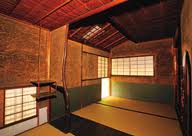 |
Sa-an Tea House
As mentioned before the San-an tea room is within Gyokurin-in temple grounds. The Sa-an tea house was designed by
Kounoike Ryouei with an attempt to keep the design in wabi style instead of the more flashy merchant status style.
Some signs of the wabi can be found in the walls which are plastered with a mixture of mud and rice stalks and preservation of rough looking wooden pillars with the bark still in tact. Another remarkable feature is that there is a wooden plank or flooring which divides the room between the host and the guests’ seating locations.
Kan’in-no-seki Tea Room
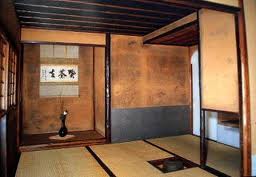 |
The Kan’in-no-seki tea room is located at Jukou-in temple on Daitokuji temple compounds. Build by Miyoshi Yoshitsugu in 1566.
This tea room features a three-tatami-mat layout with a center pillar. Both the center pillar and the alcove pillar are made from the same red pine wood. The ceiling above the host is lowered to indicate the separation between guests and host.
There are various stories which say that the great tea master Rikyu was very fond of this tea room and used it to meditate in. Rikyu and his family graves lie within the temple grounds.
Ichiriki Ochaya
This is probably the most famous of the Ochaya of Kyoto. Located on the corner of Shijo-dori and Hanamikoji-dori streets, it is only a few hundred meters from Yasaka Jinja and is in the heart of Gion. About 300 years old, the red walled Ichiriki Ochaya is noted for its traditional architecture and atmosphere, and also for the history that has occurred here.
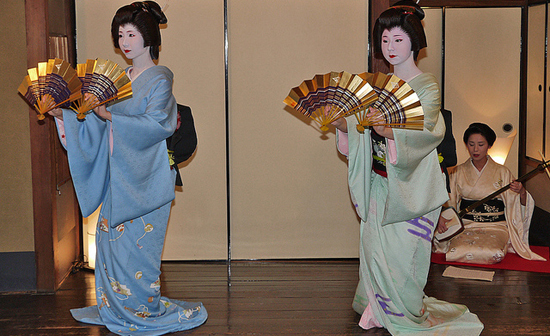
The term Ochaya, is often translated into English as Tea House. However an establishment such as the Ichiriki Ochaya is not a place for drinking tea. This is an ultra exclusive, invitation only, place of entertainment where if you need to know the price, you definitely won’t be able to afford it. A single night of geiko entertainment with geiko and maiko in attendance will cost anything from 500-800,000 yen upwards. You cannot enter Ichiriki Ochaya. To visit requires a relationship, something that may take generations, and a lot of money. A lot of money alone will not suffice. Most of the customers are male, in many cases their connection between them and the Ichiriki is through their company, however female customers are not unusual and have been for more than 100 years.
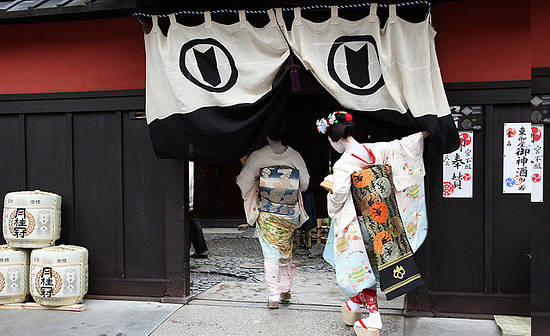
Right at the entrance of the Hanami-koji street from Gion, the famous Kyoto district of geiko (geisha in the Kyoto dialect), you will find the most famous geisha tea house (ochaya), the Ichiriki Chaya. Established over 300 years ago, this ochaya is also one of the oldest tea houses and it became famous because the leader of the Forty-seven Ronin, Oishi Kuranosuke, spent here several nights to deceive the potential spies. A Kabuki play about this event became a huge success and since the ochaya was featured in the play, it soon became famous throughout Japan.
you will notice that some traditional buildings, especially tea-houses from the geiko district, are painted with a beautiful red-ocher color. This very special shade of red is obtained from a pigment extracted from the soil rich in iron oxide from Bengal, India, hence its Japanese name, bengara. The pigment, besides its great aesthetic role, protects the wood, making it resistant to sunlight and heat.


